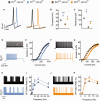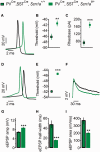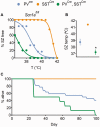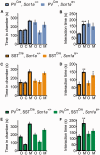Dissecting the phenotypes of Dravet syndrome by gene deletion
- PMID: 26017580
- PMCID: PMC5022661
- DOI: 10.1093/brain/awv142
Dissecting the phenotypes of Dravet syndrome by gene deletion
Abstract
Neurological and psychiatric syndromes often have multiple disease traits, yet it is unknown how such multi-faceted deficits arise from single mutations. Haploinsufficiency of the voltage-gated sodium channel Nav1.1 causes Dravet syndrome, an intractable childhood-onset epilepsy with hyperactivity, cognitive deficit, autistic-like behaviours, and premature death. Deletion of Nav1.1 channels selectively impairs excitability of GABAergic interneurons. We studied mice having selective deletion of Nav1.1 in parvalbumin- or somatostatin-expressing interneurons. In brain slices, these deletions cause increased threshold for action potential generation, impaired action potential firing in trains, and reduced amplification of postsynaptic potentials in those interneurons. Selective deletion of Nav1.1 in parvalbumin- or somatostatin-expressing interneurons increases susceptibility to thermally-induced seizures, which are strikingly prolonged when Nav1.1 is deleted in both interneuron types. Mice with global haploinsufficiency of Nav1.1 display autistic-like behaviours, hyperactivity and cognitive impairment. Haploinsufficiency of Nav1.1 in parvalbumin-expressing interneurons causes autistic-like behaviours, but not hyperactivity, whereas haploinsufficiency in somatostatin-expressing interneurons causes hyperactivity without autistic-like behaviours. Heterozygous deletion in both interneuron types is required to impair long-term spatial memory in context-dependent fear conditioning, without affecting short-term spatial learning or memory. Thus, the multi-faceted phenotypes of Dravet syndrome can be genetically dissected, revealing synergy in causing epilepsy, premature death and deficits in long-term spatial memory, but interneuron-specific effects on hyperactivity and autistic-like behaviours. These results show that multiple disease traits can arise from similar functional deficits in specific interneuron types.
Keywords: Dravet syndrome; Nav1.1; interneurons; parvalbumin; sodium channel; somatostatin.
© The Author (2015). Published by Oxford University Press on behalf of the Guarantors of Brain. All rights reserved. For Permissions, please email: journals.permissions@oup.com.
Figures









Comment in
-
Phenotypes of Dravet Syndrome.Pediatr Neurol Briefs. 2016 May;30(5):28. doi: 10.15844/pedneurbriefs-30-5-1. Pediatr Neurol Briefs. 2016. PMID: 27617639 Free PMC article.
References
Publication types
MeSH terms
Substances
Grants and funding
LinkOut - more resources
Full Text Sources
Other Literature Sources
Molecular Biology Databases

